Search the Special Collections and Archives Portal
Search Results
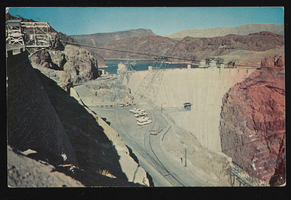
View of Hoover Dam with Lake Mead in background: postcard
Date
1900 (year approximate) to 1999 (year approximate)
Archival Collection
Description
From the UNLV Libraries Single Item Accession Photograph Collection (PH-00171)
Image

Welders making modifications to the Hoover Dam: photographic print
Date
1951-11
Archival Collection
Description
From the Morgan Sweeney Photograph Collection (PH-00228). Intake tower, lower cylinder gate modification, showing the detail of making the cut, buring, of the lower section gate. Note that the skin-plate hanging with holes burned through for lifting out, you can also see the cutting machine and guide detail. The welders from left to right are E.M. Fitzgerald and Oulie Cameron in November 1951.
Image
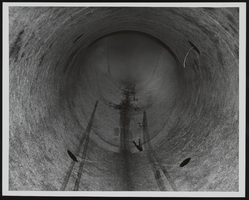
Interior view of A 8-9 penstock at the Hoover Dam: photographic print
Date
1954-05-21
Archival Collection
Description
From the Morgan Sweeney Photograph Collection (PH-00228). Interior view of A-8-9 penstock. Dark spots at 45 degree from vertical and horizontal mark the location of lower set of piezometer taps. Taps locations have been cleaned and repainted. Note wire projecting into penstock, upper right, locating tap hole. Pool of water visible at bottom, tire hoist inside 30-foot penstock at top of raise.
Image
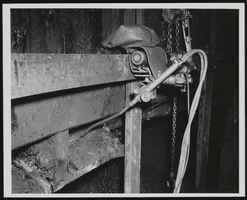
Number 5 intake towerat the Hoover Dam: photographic print
Date
1959-03-06
Archival Collection
Description
From the Morgan Sweeney Photograph Collection (PH-00228). No. 5 intake tower, lower cylinder gate modification, the Oxweld cutting machine mounted on guide rail for angle cut on 2-inch plate, using long off-set tip (the short tip used on, inch skin plate on March 12, 1954.
Image
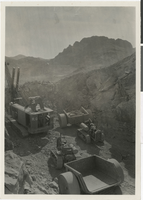
Photograph of Hoover Dam construction, June 01, 1931
Date
1931-06-01
Archival Collection
Description
Typed onto back of image: "Equipment of R. G. LeTourneau at work on highway east of switchyard, looking southeast. June 1, 1931."
Image
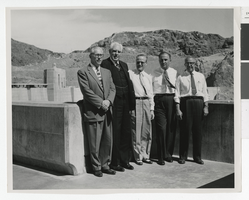
Photograph of men at Hoover Dam, May 26, 1954
Date
1954-05-26
Archival Collection
Description
L-R: Spencer Butterfield, State Bond Chairman, National U.S. Savings Bond Director Earl O. Shreve, J.P. Jones, Reclamation Regional Director, Arnold J. Raven, Regional Bond Sales Director, and State Bond Sales Director V.A. Ninnie.
Image
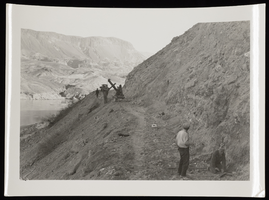
Photograph of road construction, Hoover Dam, circa 1933
Date
1932 to 1934
Archival Collection
Description
View of workers cutting a road about 3 1/2 miles above the Dam site. Note on back: ""Clyde in photo. I hired out to Clark County as a powdermonkey on this road. Road was 8 feet wide. Went to Schwartzs'. Road was only a mile long. Whenever we ran out of lumber Lacey's wife would go to Salt Lake to raise money. - W.A. Davis.""
Image
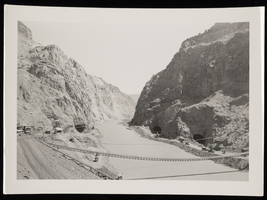
Photograph overlooking stream, Hoover Dam, circa 1932.
Date
1931 to 1933
Archival Collection
Description
Aerial photo looking upstream before coffer dam was started; diversion tunnels cut and suspension foot bridge completed. Lower catwalk was four feet wide for personnel traffic only. 600 ft. ladder at end went up canyon wall in 40 ft. sections. "First bridge built in the lower canyon. - W.A. Davis, 1992"
Image
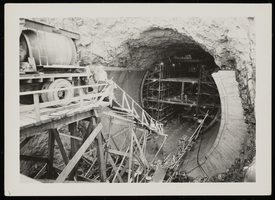
Photograph of diversion tunnel, Hoover Dam, circa 1932
Date
1931 to 1933
Archival Collection
Description
Outside of diversion tunnel No.2; shows side walls and jumbo inside. Notes with image: "The side wall forms were then put in there place and section after section side wall poured. Center is slip form. 1st pour on the side walls. Jumbo forms in place. Duck holes-doors used for sequential pours were on the jumbo. - W. A. Davis, 1992."
Image
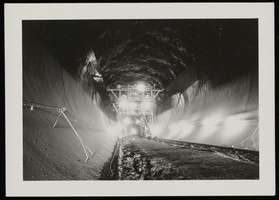
Photograph of diversion tunnel, Hoover Dam, circa 1932
Date
1931 to 1933
Archival Collection
Description
Placing concrete liner in diversion tunnel, 3 feet thick. Note on back of image: "Photo taken at night. Pour lower invert first, then side walls, then ceiling. Covered walls with asphalt to prevent rapid drying of concrete. Jumbo probably sparying asphalt in this photo. Rails visible that jumbo rode on. - W. A. Davis, 1992."
Image
Pagination
Refine my results
Content Type
Creator or Contributor
Subject
Archival Collection
Digital Project
Resource Type
Year
Material Type
Place
Language
Records Classification
